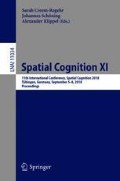Abstract
Over the past few years, a number of studies have reported on procedural similarities and differences between mental rotation and physical (i.e., manual) rotation of Shepard and Metzler-type stimuli. These similarities include comparable angular disparity effects and comparable final angular offsets in problem solving. This paper presents results from further comparisons based on gazed-derived measures obtained across the course of trials. In a within-subject design, participants solved the same tasks as mental and as physical rotation problems. We compare time courses of mean fixation duration and of saccade amplitude, and interpret these with respect to underlying mental processes and loads. The results point to additional specific procedural similarities and differences, which nicely complement the previous findings. The results are of additional, practical use for establishing how and when physical rotation can provide a useful proxy for mental rotation for purposes of process analysis, of ability assessment, and of training.
Access this chapter
Tax calculation will be finalised at checkout
Purchases are for personal use only
References
Adams, D.M., Stull, A.T., Hegarty, M.: Effects of mental and manual rotation training on mental and manual rotation performance. Spat. Cogn. Comput. 14(3), 169–198 (2014). https://doi.org/10.1080/13875868.2014.913050
Bertel, S., Wetzel, S., Zander, S.: Physical touch-based rotation processes of primary school students. In: Barkowsky, T., Burte, H., Hölscher, C., Schultheis, H. (eds.) Spatial Cognition/KogWis - 2016. LNCS (LNAI), vol. 10523, pp. 19–37. Springer, Cham (2017). https://doi.org/10.1007/978-3-319-68189-4_2
Buswell, G.T.: How People Look at Pictures (1935)
Carpenter, P.A., Just, M.A.: Eye fixations and cognitive processes. Cogn. Psychol. 8(4), 441–480 (1976). https://doi.org/10.1016/0010-0285(76)90015-3
Cohen, J.: Statistical Power Analysis for the Behavioral Sciences, 2nd edn. (1988)
Gardony, A.L., Taylor, H.A., Brunyé, T.T.: What does physical rotation reveal about mental rotation? Psychol. Sci. 25(2), 605–612 (2014). https://doi.org/10.1177/0956797613503174
Holmqvist, K., Nyström, M., Andersson, R., Dewhurt, R., Jarodzka, H., Van de Weijer, J.: Eye Tracking: A Comprehensive Guide to Methods and Measures. Oxford University Press, Oxford (2010)
May, J.G., Kennedy, R.S., Williams, M.C., Dunlap, W.P., Brannan, J.R.: Eye movement indices of mental workload. Acta Psychologica 75, 75–89 (1990)
Mills, M., Hollingworth, A., Van der Stigchel, S., Hoffman, L., Dodd, M.D.: Examining the influence of task set on eye movements and fixations. J. Vis. 11(8), 17 (2011). https://doi.org/10.1167/11.8.17
Miura, T.: Active function of eye movement and useful field of view in a realistic setting (1990)
Peters, M., Battista, C.: Applications of mental rotation figures of the Shepard and Metzler type and description of a mental rotation stimulus library. Brain Cogn. 66(3), 260–264 (2008). https://doi.org/10.1016/j.bandc.2007.09.003
Recarte, M.A., Nunes, L.M.: Mental workload while driving: effects on visual search, discrimination, and decision making. J. Exp. Psychol. Appl. 9(2), 119–137 (2003). https://doi.org/10.1037/1076-898X.9.2.119
Shepard, R.N., Metzler, J.: Mental rotation of three-dimentional objects. Science 171(3972), 701–703 (1971). https://doi.org/10.1126/science.171.3972.701
Shoemake, K.: ARCBALL: a user interface for specifying three-dimensional orientation using a mouse. Graph. Interface 92, 151–156 (1992)
Unema, P.J.A., Pannasch, S., Joos, M., Velichkovsky, B.M.: Time course of information processing during scene perception: the relationship between saccade amplitude and fixation duration. Vis. Cogn. 12(3), 473–494 (2005). https://doi.org/10.1080/13506280444000409
Unema, P.J.A., Rötting, M.: Differences in eye movements and mental workload between experienced and inexperienced motor-vehicle drivers. In: Brogan, D. (ed.) Visual Search, pp. 193–202. Taylor & Francis, Abingdon (1990)
Uttal, D.H., Meadow, N.G., Tipton, E., Hand, L.L., Alden, A.R., Warren, C., Newcombe, N.S.: The malleability of spatial skills: a meta-analysis of training studies. Psychol. Bull. 139(2), 352–402 (2013). https://doi.org/10.1037/a0028446
Wai, J., Lubinski, D., Benbow, C.P.: Spatial ability for STEM domains: aligning over 50 years of cumulative psychological knowledge solidifies its importance. J. Educ. Psychol. 101(4), 817–835 (2009). https://doi.org/10.1037/a0016127
Wiedenbauer, G., Schmid, J., Jansen-Osmann, P.: Manual training of mental rotation. Eur. J. Cogn. Psychol. 19(1), 17–36 (2007). https://doi.org/10.1080/09541440600709906
Williams, L.J.: Tunnel vision or general interference? Cognitive load and attentional bias are both important. Am. J. Psychol. 101(2), 171 (1988). https://doi.org/10.2307/1422833
Zelinsky, G.J., Sheinberg, D.L.: Eye movements during parallel-serial visual search. J. Exp. Psychol.: Hum. Percept. Perform. 23(1), 244–262 (1997)
Author information
Authors and Affiliations
Corresponding author
Editor information
Editors and Affiliations
Rights and permissions
Copyright information
© 2018 Springer Nature Switzerland AG
About this paper
Cite this paper
Wetzel, S., Bertel, S. (2018). A Comparison of Mental and Physical Rotation Using Gaze-Based Measures. In: Creem-Regehr, S., Schöning, J., Klippel, A. (eds) Spatial Cognition XI. Spatial Cognition 2018. Lecture Notes in Computer Science(), vol 11034. Springer, Cham. https://doi.org/10.1007/978-3-319-96385-3_12
Download citation
DOI: https://doi.org/10.1007/978-3-319-96385-3_12
Published:
Publisher Name: Springer, Cham
Print ISBN: 978-3-319-96384-6
Online ISBN: 978-3-319-96385-3
eBook Packages: Computer ScienceComputer Science (R0)

